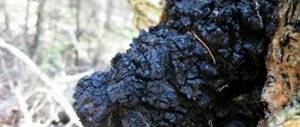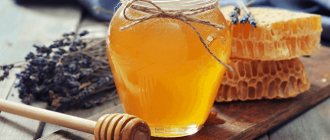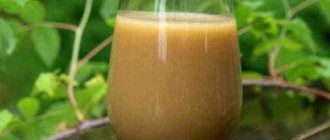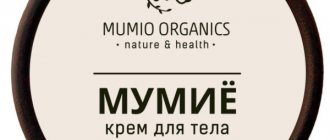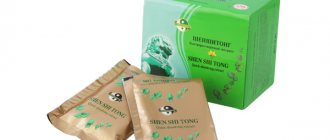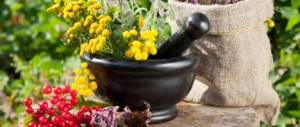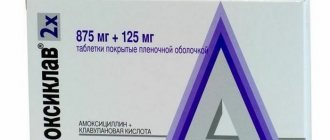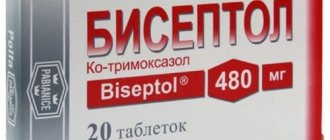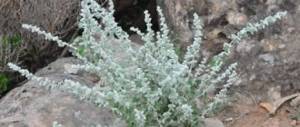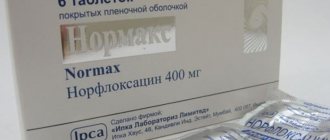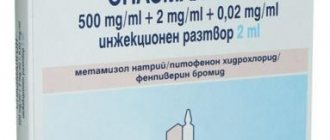Treatment using milk thistle
What does milk thistle treat?
How to use?
Milk thistle is taken in the form of decoction, infusion, powder, tea, tincture, syrup, tablets. Milk thistle can also be included in other medications.
The seeds are consumed in ground form, in the amount of 20 g per day (the powder is taken half an hour before meals, washed down with water). The daily dose is evenly distributed throughout the day.
You can brew the daily dose of powder in the evening (powder is poured into a thermos and filled with boiling water). This infusion is drunk the next day.
If milk thistle is included in medications, then you must follow your doctor’s recommendations or read the leaflet provided by the manufacturer of the medicine.
How to brew milk thistle?
To brew milk thistle, 2 tbsp. crushed raw materials (these can be plant roots or seeds) pour 500 ml of boiling water, after which the product is placed in a water bath for 20 minutes. The infusion, strained, squeezed and brought to its original volume with boiled water, is taken half a glass three times a day.
Important! Milk thistle preparations are taken half an hour before meals, or an hour after.
Course of treatment with milk thistle preparations
The duration of treatment with milk thistle is from one to one and a half months (it all depends on the type of disease, its severity and the patient’s well-being). If necessary, you can repeat the course of treatment.
For preventive purposes, it is recommended to take milk thistle preparations at least twice a year – in spring and autumn, when the body needs additional protection.
Most often, positive reviews about milk thistle can be heard in the treatment of the liver. Patients say that the plant actually helps get rid of problems with this organ. Milk thistle is also noted to help with intoxication of the body, including alcohol.
Reviews also indicate that in most cases, milk thistle improves the general condition of the skin and joints, and migraines go away. This plant is also used for weight loss.
Reviews mostly boil down to the fact that this is a good aid for weight loss, capable of cleansing the body and removing toxins. But not everyone notices the obvious effect of losing extra pounds.
Some people note that milk thistle reduces appetite.
But not all reviews about milk thistle are positive. Some patients who took this plant reported stomach pain, nausea, and indigestion.
What types of liver ailments does milk thistle treat?
Firstly, milk thistle perfectly protects the liver and other internal organs from the toxic effects of the environment. Its course is recommended even for those who have undergone chemotherapy or received radiation.
Secondly, silymarins protect the liver from oxidation and support the liver during cirrhosis.
Thirdly, it helps cope with liver diseases!
Milk thistle is used for:
- Chronic hepatitis.
- In case of disruption of contractions of the gallbladder and its ducts.
- Increased amount of urate in urine.
- For cholecystitis.
- Kidney stone disease.
- Various toxic lesions.
- Prevents fibrosis.
- Alcohol lesions.
Meal is formed by pressing oil from seeds. The substance has the form of a powder and is characterized by a high fiber content.
Treatment of kidney inflammation with folk remedies
Treatment of kidney inflammation with folk remedies is currently one of the most popular methods of eliminating the manifestations of the disease.
- Briefly about inflammation and its genesis
- Indications for alternative treatment
- Nutritional Features
- The most common recipes
- Recipe 1. Effective herbal infusion with a pronounced diuretic effect
- Recipe 2. Parsley decoction with milk
- Recipe 3. Lingonberry jelly
- Recipe 4. Herbal infusion
- Recipe 5. Herbal mixture for nephritis of bacterial origin
- Prevention
This method of disease correction can be used as an auxiliary technique to the main therapy with traditional pharmaceutical drugs, and can also be an independent way to combat the pathological process.
In addition, folk recipes in most cases help prevent the development of the disease and several times reduce the risk of exacerbation of chronic inflammation.
According to statistical studies, inflammatory kidney diseases (nephritis) are diagnosed in almost every 30 residents of our state, regardless of their age, gender and social status.
Timely identified ailments of the renal sphere can be easily corrected, which allows patients to get rid of the pathological process and prevent its possible complications, which in most cases are accompanied by gross disturbances in the functioning of the main urinary organs.
Briefly about inflammation and its genesis
Inflammatory processes in the night are a group of diseases in which organ tissues are affected and their function is disrupted. In medicine, several types of renal inflammation are distinguished, namely pyelonephritis or infection of the renal pelvis, glomerulonephritis, when the structure of the pathology involves the glomeruli and interstitial nephritis with painful changes in the interstitial structures.
Factors that provoke the appearance of symptoms of the disease include:
- general hypothermia of the body;
- sedentary lifestyle;
- low level of immune reactivity;
- alcohol abuse;
- low quality nutrition and inadequate drinking regime;
- the presence of chronic foci of infection in the body;
- working and living in conditions of high humidity;
- frequent stress.
Often the kidneys become inflamed due to other pathologies, including:
- allergic reactions;
- diabetic nephropathy;
- infectious diseases of blood vessels and atherosclerotic damage to their walls;
- intoxication of various origins (salts of heavy metals, viruses, bacterial infection, toxic substances, etc.).
Timely diagnosed symptoms of kidney inflammation in adults and children are an important stage on the path to recovery, which allows a sick person to quickly respond to the development of the pathological process and take the necessary measures to eliminate it.
The main symptom of nephritis is aching (sometimes sharp) pain in the lumbar region, which does not depend on turning or bending the body, is predominantly stable and tends to intensify after physical activity.
In addition, patients complain of a rise in general body temperature, changes in the quality of urine and an increase in the frequency of urination, pain during trips to the toilet, malaise, loss of appetite and performance.
Treatment of kidney inflammation is aimed at eliminating pain, eliminating the source of infection, activating regeneration processes of affected tissues, stimulating defenses, as well as removing sand and stabilizing the general state of human health.
In classical medicine, such therapy is implemented by prescribing diuretics, antibacterials, antihistamines, vitamins, glucocorticosteroids and calcium to patients.
Additionally, patients take antipyretic drugs, medications with immunostimulating, anti-inflammatory effects that normalize adequate blood flow.
Modern nephrologists do not deny the effectiveness of well-known folk remedies, therefore they often recommend them to their patients as an auxiliary treatment for renal pathology.
Some plants actually have healing properties. Thanks to them, it is possible to get rid of inflammation, increase immunity, eliminate swelling and remove sand from the renal tract.
Indications for alternative treatment
The predominant number of nephritis is characterized by the same signs of the inflammatory process, since most symptoms are the result of a violation of the filtration function of the kidneys.
Therefore, it is customary to highlight the following indications for the prescription of folk remedies for the correction of the pathological process:
- the appearance of swelling in the face and lower extremities;
- pain in the lumbar area;
- increase in general temperature;
- the appearance of red blood cells in urine tests (hematuria);
- decrease in the amount of urine excreted;
- dark circles under the eyes.
Kidney therapy with folk remedies has a number of advantages, including:
- absence of negative effects on the body;
- mild effect of herbal infusions and decoctions;
- efficiency.
Despite all the positive aspects, folk remedies that restore kidneys have several contraindications for use. They should not be used by people suffering from acute forms of nephritis, which are accompanied by fever, lack of urine, intense pain, resistant to analgesics.
A practicing andrologist tells more about the types, treatment and symptoms of nephritis in the video below.
It is not recommended to use such dosage forms for pregnant women, heart patients, and allergy sufferers.
Nutritional Features
Symptoms and treatment of inflammation of the renal tissue largely depend on the diet of the sick person.
An unbalanced diet with a high amount of salt can provoke an exacerbation of the pathological process, reduce the effectiveness of medications and aggravate the course of the disease. That is why, in parallel with the main therapy, specialists prescribe a diet to their patients.
Doctors recommend that in case of kidney inflammation, limit fluid intake to 1.5-1.7 liters per day, which will prevent the appearance of edema. It is strictly prohibited to include salty foods, smoked foods, spicy marinades and preserves in the diet. During the treatment period, you should not eat sausages, fatty meats, a lot of flour and sweets.
When compiling a daily menu, attention should be paid to rye bread, bran, eggs, chicken, fresh vegetables and fruits. The best salad dressing in this case is olive or flaxseed vegetable oil, and herbs, in particular basil, parsley, dill, and green onions, will help enhance the taste of dishes.
For patients with kidney damage, it is better to avoid alcoholic beverages, coffee and soda.
The most common recipes
Kidney diseases should be treated using traditional recipes only under the supervision of the attending physician, who will advise a truly effective remedy in each specific clinical case, rule out the patient’s contraindications to its use, and prescribe adequate dosages of the medication.
Currently, many recipes are known to improve the condition of the kidneys and stop the progression of chronic inflammation in their parenchyma. Here are the most popular ones.
Recipe 1. Effective herbal infusion with a pronounced diuretic effect
You will need:
- asparagus – 1 part;
- parsley root – 1 part;
- fennel – 1 part;
- celery – 1 part.
All components should be crushed and mixed. To prepare the decoction, take a tablespoon of the resulting mixture and pour a glass of cold water.
After soaking the product for several hours, it must be brought to a boil and cleaned of the cake. Take the prepared broth several small sips throughout the day.
This healing infusion perfectly cleanses the kidneys of toxins, has an excellent diuretic and anti-inflammatory effect, so it is useful to use not only for nephritis, but also in case of infection spreading to the urinary tract.
Recipe 2. Parsley decoction with milk
You will need:
- parsley root – 2 pieces;
- milk – 0.5 l.
Clean the parsley roots from dirt and grate them on a fine grater. Pour the resulting slurry with milk and water in equal quantities. Boil the mixture over low heat for about 10-15 minutes, then cool and take 100 ml three times a day after meals.
Such treatment with parsley root is a very effective way to eliminate the manifestations of chronic infection in the kidneys. Its only drawback is the duration of the therapeutic course, which should not be less than 12 months.
Recipe 3. Lingonberry jelly
You need to take:
- lingonberries – 0.5 kg;
- sugar – 1 kg.
Grind fresh berries in a blender and mix with sugar. Then put the resulting jelly into small jars, which should be stored in the refrigerator. If necessary, dilute a tablespoon of jelly in 100 ml of warm water and take twice a day.
This product perfectly suppresses the manifestations of inflammation, helps eliminate swelling, improves immunity and saturates the human body with valuable vitamins.
Lingonberry jelly is an ideal herbal medicine for the youngest patients who refuse bitter medications.
Recipe 4. Herbal infusion
Would need:
- half-fallen grass – 10 g;
- boiling water – 200 ml.
Pour a glass of boiling water over the crushed parts of the plant and leave for no more than two hours. The finished infusion should be taken warm and three tablespoons after meals.
As you know, a product based on pol-palm has a detrimental effect on tooth enamel, so after each use it is recommended to rinse the mouth with a soda solution.
The healing infusion is indicated for patients suffering from inflammation of the kidneys and urinary tract, as well as those with urolithiasis who want to get rid of stones.
Recipe 5. Herbal mixture for nephritis of bacterial origin
To prepare the product you need to take:
- yarrow herb – 1 part;
- garden currant leaves – 1 part;
- succession grass – 1 part;
- dead nettle flowers – 1 part;
- burdock roots – 2 parts;
- wild strawberry leaves – part 2;
- violet trifoliate herb – 2 parts;
- birch buds – 2 parts;
- bearberry leaves – 3 parts.
Pour two tablespoons of herbal mixture into 1 liter of warm water and boil for 15 minutes over low heat. Take the finished decoction 50 g every two hours for exacerbations of chronic nephritis.
Prevention
After treating kidney inflammation with folk remedies, a person should not relax. On the contrary, it is important to take care of your health, since chronic diseases of the renal area tend to recur frequently.
To prevent this from happening, patients must change their lifestyle and diet, paying more attention to their own body.
Nonspecific prevention of nephritis includes several important points, namely:
- normalization of daily nutrition with the exception of salty foods, smoked foods and marinades;
- adequate drinking regime;
- quitting smoking and drinking alcohol;
- correction of working conditions and provision of adequate rest;
- avoiding hypothermia;
- timely identification and treatment of chronic ailments of internal organs, in particular the stomach, mucous membranes of the oral cavity, tonsils, and genital area;
- regular preventive examinations with tests.
Prevention of kidney inflammation occupies an important place in the structure of measures aimed at eliminating the infectious process of the organ parenchyma.
Therefore, methods for preventing the disease should not be neglected, which will help maintain the health and normal functionality of the urinary system.
Any traditional method of treating kidney diseases must be agreed with your doctor. For a method of treating and cleansing the kidneys with soda, watch the video below.
Drug interactions
Seeds (fruits)
Preparations from milk thistle fruits are used for liver diseases,
and spleen, for alcohol and food poisoning. In addition, the seeds of the plant are an excellent prophylactic agent, indicated for use by residents of environmentally unfavorable regions. It is recommended to use the seeds for people involved in hazardous industries and athletes under high physical activity.
Leaves
The leaves of the plant are used as a light
, diuretic, choleretic and diaphoretic.
Root
In order to understand the benefits of Milk Thistle, the medicinal properties of which have a beneficial effect on the treatment of various diseases of the liver, gall bladder and strengthen the body, it is worth paying attention to the composition of the product.
Whatever form you purchase the medicine in, it contains the Milk Thistle extract itself, which includes silymarin, as well as excipients and various nutritional supplements that accelerate the effect of the drug.
The use of Milk Thistle may weaken the effect of hormonal contraceptives, as well as medications intended for hormone therapy.
An enhanced treatment effect is observed when silymarin interacts with:
- ketoconazole,
- lovastatin,
- Vinblastine.
Description
The plant has rather large leaves, glossy, shiny, slightly wavy. The inflorescences and stems of the plant have yellow spines. The plant blooms from July to August. The flowers are purple, pink or red, tubular, numerous, collected in spherical inflorescences-baskets.
The fruits are ovoid brown or black achenes with a tuft.
The plant is classified as a weed. Distributed throughout Europe, Russia, and Asia.
Milk thistle fruits – seeds without a tuft – have been used as a medicinal raw material.
Application of the plant
Seeds (fruits)
Leaves
Root
Infusion
This form of milk thistle preparations is indicated for restoring liver function, removing bile, and eliminating pain from joint diseases.
2 tbsp. Place milk thistle seed powder in a thermos and pour 500 ml of boiling water, then leave the product for 12 hours, strain, squeeze thoroughly and drink 130 ml four times a day.
Tincture
Milk thistle tincture is widely used in dermatology to treat skin diseases.
Pour 50 g of seeds into half a liter of vodka, leave for two weeks (necessarily in a dark place), shaking occasionally. The strained tincture is taken 20 drops three times a day.
Indicated for all liver diseases,
, kidney. Also used in the treatment of cancer.
30 g of seeds are boiled in 500 ml of water over low heat until half of the water has boiled away. A tablespoon of decoction is taken every hour (for example, from nine in the morning to nine in the evening) for three weeks, after which a break is taken for two weeks.
Milk thistle herbal tea in bags
Pharmacy herbal tea improves the digestion process, normalizes the functioning of the liver, gives strength and energy. A tea bag is brewed with boiling water, steeped for 10 minutes and drunk three to four times a day.
Pharmaceutical milk thistle syrup is indicated for diseases of the liver, biliary tract, and spleen. In addition, syrup is prescribed for gallstone disease,
and respiratory organs 1 tbsp. three times a day.
The juice of this plant removes
, improves the functioning of the gastrointestinal tract, normalizes metabolism, cleanses the skin, and relieves inflammation.
Milk thistle meal has approximately the same contraindications as when taking any other parts and compositions with its use. Pregnant and lactating women can use it only on the recommendation of a doctor, following the dosage and dosage regimen prescribed by him.
All persons suffering from cholelithiasis, regardless of stage and condition, can begin taking the meal only after a medical examination and under strict medical supervision. People prone to allergic reactions should start taking milk thistle meal with caution.
It is not recommended for children under 12 years of age to take the meal, like other milk thistle products.
Milk thistle oil should not be used, especially internally, by children under three years of age. It is possible, but only use it externally with caution.
Milk thistle oil has contraindications such as individual intolerance and a tendency to allergic reactions. You should use this oil with extreme caution for cholecystitis and cholelithiasis, and before starting use, be sure to consult with your doctor.
The fruits, seeds and flowers of the plant are used to prepare medicines used to treat various diseases. The drugs are quite effective in the fight against various types of intoxication (alcohol, drugs), toxicosis, food poisoning and AIDS.
Milk thistle can be used to prepare medicines in various forms. The method of application directly depends on the nature of the disease, and this must be taken into account in order for milk thistle treatment to be effective.
- Powder. Prepared from seeds. Used mainly to treat cardiovascular diseases and also to lower blood sugar. In addition, the powder improves the functioning of the digestive system, metabolic processes, and increases appetite.
- Decoctions. Mainly used to treat liver and gallbladder diseases. Also recommended for use in case of obesity. Treatment with decoctions can last no more than 2 months.
- Tincture with alcohol. It is taken for severe poisoning, as well as to cleanse the body of toxins. Can be used after long-term treatment with antibiotics, chemotherapy and other treatments that are potentially harmful to the body.
- Tea. Prescribed for the treatment of inflammatory diseases of the gastrointestinal tract. It can also be taken to treat kidney stones and varicose veins.
- Oil. Milk thistle oil obtained from compressed seeds helps with hepatitis and jaundice. The medicine is often taken to eliminate the symptoms of dysbiosis, food poisoning and some gynecological pathologies.
In general, the method of using milk thistle depends on the nature of the disease and the desired therapeutic effect.
Milk thistle has been used for a long time as a powerful medicine in official and folk medicine for the treatment of liver diseases such as cirrhosis and jaundice.
Milk thistle is most often used in the following cases:
- to protect the liver from various toxins and to alleviate the condition of cirrhosis and hepatitis;
- to reduce liver damage due to alcohol dependence;
- with cholelithiasis.
However, there are numerous positive reviews of milk thistle used to treat diseases of the respiratory system, spleen, heart and pancreas.
Milk thistle is used for gallstone disease, cholecystitis and diseases of the genitourinary system, diabetes, for diseases of the spleen, thyroid, gastrointestinal tract, for the treatment of the cardiovascular system, for radiculitis and salt deposits, for joint pain, for dilated veins and hemorrhoids, for psoriasis , acne, baldness, diseases of the respiratory tract and oral cavity.
With the help of milk thistle, edema and dropsy are treated, and it also helps fight excess weight.
It is used for poisoning caused by alcohol, toxins, drugs, narcotic substances, radiation, to cleanse the liver and blood, after a course of chemotherapy.
Milk thistle is used in the treatment of hemorrhoids and colitis. To treat various diseases, milk thistle meal is used according to the following scheme: three times a day, 30 minutes before meals, one teaspoon of dry powder is washed down with warm water. The recommended course of treatment is 40 days; after a two-week break, if necessary, the course of treatment is repeated, but no more than four times a year.
Meal is mainly prescribed for the treatment of adult patients, but for special indications it can also be used for children from 3 years of age. Children are prescribed a daily dose of the drug (meal) of 0.5 tsp, twice a day; it is better to add the powder to warm tea or mix it with cold dishes. The dosage of silicide, a special product from milk thistle, is 160-480 mg per day.
Milk thistle is part of pharmacological preparations and is widely used in dermatology, homeopathy, and for the manufacture of dietary supplements.
In cooking, milk thistle flour is added to confectionery and bakery products, and is also used in the production of soft and alcoholic drinks.
Milk thistle seed oil is used not only for treatment, but also for dietary and diabetic nutrition, and is added to porridges and salads. The oil is used in cosmetology for hair care, facial skin, hand care, and for massage.
- Adults are prescribed 70-140 mg 2-3 times a day. For maintenance therapy, 70 - 140 mg 2 times a day.
- Children - 30 - 100 mg 3 times a day. For maintenance therapy, 30–70 mg 2 times a day.
Efficiency is achieved when taken in courses lasting at least 3 months. Milk thistle seed oil should be consumed 1 - 2 teaspoons 2 times a day with meals. Do not subject to heat treatment. The course of admission is 30 days.
As a rule, preparations with Milk Thistle sold in pharmacies are required for use for the following diseases:
- Fatty hepatosis.
- Hepatitis C.
- Lipid metabolism disorders.
- Hepatitis, including chronic.
- Alcohol and toxic poisoning.
- Cirrhosis of the liver.
- Liver damage due to working in industrial plants or living in areas with poor ecology.
- Pancreatitis.
- Prevention of poisoning and various liver diseases.
Many people wonder how to drink Milk Thistle: before meals or after? There are no special instructions for the time of use, and you can use the drug at any time convenient for you, evenly distributing the dose throughout the day.
If you want to independently prepare a decoction or tincture from this medicinal herb, you can subsequently use the resulting solution for:
- Losing weight.
- Skin cleansing.
- Hair strengthening.
Let's consider each of the methods of using the medicine in more detail.
Losing weight
Drinking thistle (Milk thistle) tea for weight loss is a great way to lose weight:
- Firstly, syrups and tinctures from fruits accelerate metabolism, which is necessary not only for losing weight, but also for further maintaining the body in shape.
- Secondly, the seeds of this plant cleanse the body of harmful substances accumulated over a long period of time.
- Thirdly, it has a laxative effect.
Herbal tea made from meal (crushed seeds) is recommended to be used for 1 to 2 months. Tea from dried milk thistle flowers provides as many benefits as bran. In addition, at the pharmacy you can buy apielixir propolis, which will help you speed up your metabolism.
Skin cleansing
Due to the fact that the active substances of the plant remove toxins from the body, your skin will become cleaner and softer. Do not worry if small rashes appear at the very beginning of the course of treatment: this problem will go away in a few days.
Hair strengthening
Vitamins A, B, C, E contained in Milk Thistle oil:
- gives shine and silkiness to hair,
- strengthen the roots.
That is why doctors advise using artichoke to treat hair. According to reviews, the most effective way to prevent hair loss is to apply slightly heated oil 30 minutes before washing your hair. It is recommended to repeat this procedure 2-3 times a week.
Beneficial properties of milk thistle tea
Tea with the plant contains more than 50 beneficial components that help support the immune system, relieve painful spasms and inflammation, get rid of pain, and also heal wounds. But the most important of all the components of the plant is considered to be silymarin, which doctors call a liver protector. Silymarin protects the organ during various inflammatory processes, in particular those provoked by viral hepatitis.
Reference! Some studies have confirmed the effectiveness of milk thistle in the fight against certain types of cancer. Silymarin enhances the protection of the epidermis and prevents the dangerous effects of ultraviolet exposure.
An aqueous tincture of milk thistle also helps liver cells recover faster in case of poisoning, and also neutralizes cells with damaged DNA. Tea is often prescribed as one of the components of complex treatment to reduce liver pressure and relieve inflammatory processes in the gallbladder.
In addition, the drink is indicated for the following diseases:
- pancreatitis, fatty degeneration and cirrhosis of the liver;
- hemorrhoids;
- diabetes mellitus and other endocrine system disorders;
- dysbacteriosis;
- chronic gastroduodenitis;
- with alcohol intoxication.
You should also pay attention to tea in order to improve vision, reduce cholesterol in the blood and strengthen capillary vessels. Often used as a diuretic. Dermatologists recommend drinking the drink for various types of dermatoses, acne and psoriasis.
Important! This simple plant helps improve your well-being without significant side effects.
Recipes with milk thistle
Seeds (fruits)
Leaves
Root
Compress for wound healing
The leaves, from which the thorns must first be cut off, are washed well and crushed to a mushy state. The resulting mixture is applied to the wound and bandaged.
, scratches and
will go away in 2-3 days if you apply such compresses daily.
Decoction for arthritis and radiculitis
A tablespoon of milk thistle roots is poured into 250 ml of hot
(it is advisable to use enamel dishes). Next, the product is placed on low heat and boiled in a closed container for another 20 minutes. Removed from the heat, the hot broth is filtered through a triple layer of gauze, after which it is diluted with boiling water to 250 ml. Take a tablespoon of the decoction three times a day.
The same recipe in the form of rinses will help cope with toothache, while taking it orally will cure urinary retention and cramps.
Decoction for liver and gastrointestinal diseases
Pour 30 g of seeds into half a liter of water, bring the product to a boil over low heat until half the liquid evaporates. The remaining broth is removed from the heat and infused for 10 minutes, after which it is carefully filtered and taken 1 tbsp. every hour for twelve hours. The course of treatment with this decoction is 21 days, then a break is taken for two weeks, and then the course continues for another 21 days.
Powder for poisoning
Seed powder can be consumed 5 times a day, one tablespoon to relieve symptoms
(the decoction should be taken at regular intervals). The course of treatment lasts until complete elimination
poisoning
In addition, milk thistle powder is indicated during radiation or chemotherapy, one dessert spoon four times a day (as in the previous case, milk thistle is taken at regular intervals). The powder is taken for 20 – 25 days.
Many parts of this plant are used to prevent and treat a wide variety of diseases. In the summer, during the flowering of milk thistle, juice can be squeezed out of the large lower leaves, which is good for varicose veins.
An infusion with a mild laxative effect can be prepared from dried leaves. You can brew tea from the seeds, which has a stimulating effect on the gastrointestinal tract and activates the immune system.
For bleeding gums, milk thistle root powder brewed in water can be used as a rinse. The meal and oil of this plant can be bought at almost any pharmacy or you can make it yourself.
Let's figure out what diseases they can be used for, and whether there are any contraindications to their use.
Almost any medicine that contains milk thistle herb can be purchased at a pharmacy or specialized stores without any problems. However, many medicines can be prepared at home using the dried plant.
It is important to remember that prolonged exposure to light, as well as high temperatures (more than 60 degrees) contributes to the loss of beneficial qualities due to the destruction of silymarin compounds.
- Shrot. It is necessary to grind the milk thistle grains using a coffee grinder or a regular mortar. Use the resulting powder 1 spoon 4 times daily. It is best to take it before eating. The duration of use is about 40 days with breaks between courses of 2 weeks.
- Alcohol tincture. You need to mix 50 g of powder and 0.5 l of vodka. The medicine must be infused for at least 2 weeks. From time to time the medicine should be shaken a little. Should be taken every day 3-5 times, 25 drops, with plenty of water.
- Decoction. To prepare, you need to grind 30 g of seeds into a powder mixture. The resulting powder is poured into 0.5 liters of water and kept over low heat until a significant amount of liquid has boiled away. You need to take 1 spoon every hour, from 8 a.m. to 8 p.m. One course of treatment is 3 weeks, and the break is 14 days.
- Tea. To prepare a medicinal drink, you can use both seeds and crushed milk thistle herb. You need to pour 1 teaspoon of the suitable raw material with a glass of boiling water and leave for about 10 minutes. You should drink it hot in small sips, after straining it. It is recommended to take it in the morning before breakfast, as well as at noon and before going to bed.
- Sprouted seeds. This method of use also helps with liver diseases and has an anti-inflammatory effect. To germinate the seeds, you need to wash them and leave them in water for several hours. After this, the water is drained and the seeds should be placed in a bright place. The first sprouts appear, as a rule, on the 2-3rd day, and they should be eaten 1 spoon daily.
In addition to traditional medicine, milk thistle is the main active ingredient in many pharmaceutical products in tablet form. Such medications can only be taken as prescribed, in accordance with the rules specified in the instructions.
Speaking about how to drink milk thistle for the liver, it should be noted that this medicinal plant is used to prepare medicines in different forms.
Medicinal properties of milk thistle
Meal is a by-product of the production of oil from milk thistle seeds by cold pressing. In fact, these are seed shells crushed to the smallest husk. In medical practice it is used for preventive and health purposes.
As an auxiliary drug, meal is included in treatment programs for pathologies of the gastrointestinal tract, liver, skin diseases, and intoxication conditions. Application possibilities arise from the unique composition of the raw materials.
Milk thistle seeds and cake are recognized as the best liver protectors.
Used as a preventive and therapeutic agent:
- to protect hepatocytes from the effects of aggressive compounds and external factors, cleansing the organ;
- blocking the reproduction of the hepatitis C virus;
- restoration of cell membranes, stimulation of protein synthesis and the formation of new cells, normalization of metabolic processes in the liver.
The benefits of the cake are not limited to its hepatoprotective effect.
It is known that crushed seed husks:
- promotes the formation of bile, has a mild choleretic property;
- normalizes the functioning of the pancreas and gastrointestinal tract;
- improves intestinal motility;
- restores microflora;
- neutralizes free radicals due to a complex of antioxidants (vitamin E, carotenoids, polyunsaturated fatty acids, silymarin);
- has a beneficial effect on the central nervous system;
- improves psycho-emotional background (due to the combined action of B vitamins and minerals);
- prevents thrombosis;
- strengthens the walls of blood vessels;
- improves metabolism;
- promotes the breakdown of fats;
- reduces the concentration of bad cholesterol;
- removes toxins, heavy metal salts, radionuclides;
- in cancer patients, meal helps to remove tumor decay products and reduce general intoxication of the body, improve well-being during chemotherapy and radiation.
Low calorie content combined with high nutritional value allows you to include pulp in weight loss programs. The absorbent properties of raw materials are appreciated in cosmetology: scrubs and cleansing masks with husks get rid of acne, dead skin flakes, and increase skin elasticity.
Medicinal herbal tinctures are alcoholic extracts of active substances from dry or fresh raw materials. They are prepared with 40-90% medical alcohol or vodka. This form of drugs is characterized by high concentration and bioavailability of substances.
Cooking feature:
- no heating;
- long-term exposure in a dark, warm place (20-24°C);
- low dosage.
At home, high-quality vodka is usually used. If you take alcohol instead of vodka, it must be diluted with distilled water to 40-50%. At a higher concentration, the active substances of the cake are less extracted.
Preparation of tincture:
- pour 100 g of raw materials into a 1.5 liter container. Pour 1 liter of vodka, close the lid tightly;
- put in a dark place at room temperature for 20 days.
- Shake the composition vigorously every 5 days. Pour the finished mixture into another container, squeezing the pulp well through clean gauze.
How to use:
- 15-30 drops (depending on the disease) are dissolved in 30-45 ml of water;
- The drug is taken 20-30 minutes before meals 3 times a day.
The tincture is used:
- to cleanse and rejuvenate the body;
- as an immunomodulator;
- with a hangover;
- as a supplement for removing parasites;
- as an effective pain reliever.
Instructions for using dry milk thistle meal assume that the raw material is well crushed and free of foreign matter. The main indications are bowel cleansing, recovery after radiological treatment or poisoning, long-term use of antibiotics.
For one-time use, 1 tsp is enough. cake. The frequency of administration is 3 times a day, the duration of the course, depending on the problem, is 14-21 days.
In case of hypotosis, the technology for preparing medicinal compositions is based on taking into account the patient’s body weight.
Preparation of the decoction:
- the cake is taken at the rate of 1 g for each kg of weight, 0.5 l of water is required;
- Boil the solution over low heat until the liquid is reduced by half (250 ml);
- The broth should cool at room temperature, after which it is filtered.
The resulting composition is topped up only if the volume has decreased by more than 2 times. Moreover, you need to bring it to 250 ml. Liver cleansing: every hour you need to take 1 dess. l. drug regardless of food intake. You should start at 8 a.m. and finish by 9 p.m.
Milk thistle meal for liver diseases, according to the instructions for use, should be taken 1 dessert spoon, regardless of meals.
For chronic liver diseases, in severe situations, it is necessary to take 2-3 courses of 20 days each. In this case, you need to strictly adhere to the proposed scheme and always prepare fresh decoctions or tinctures.
Thanks to its fine-grained structure and adsorbing properties, milk thistle meal perfectly cleanses and evens out the skin. The vitamin and mineral composition nourishes and moisturizes the dermis, and bioactive substances stimulate metabolic processes and tissue regeneration. The cosmetic effect is complex.
Scrub with milk thistle meal at home:
- Dilute 15-20 g of raw material with water to the consistency of a thick paste;
- add 3-4 drops of wheat germ oil and 2-3 drops of lemon juice;
- Stir thoroughly and leave at room temperature for 10-15 minutes.
The scrub is applied to the face in a thick layer and left for 1 minute. After this, rub into the skin for 3-5 minutes. The composition is washed off with lukewarm running water. For a visible effect, you will need 10-15 procedures, 2-3 times a week.
50-70 ml of softened honey is mixed with 10 g of dry meal. The mixture is rubbed into problem areas, and the top is wrapped with cling film and a warm cloth. Application time 30 min.
Milk thistle meal, the instructions for use of which for medicinal purposes suggest a powder preparation, must be carefully selected correctly.
There are 3 important points:
- Optimal packaging. The transparent bag allows you to visually check the quality of the cake. Its heterogeneous structure is allowed, but there should be no foreign impurities, pieces of stems and leaves.
- Color of the drug. It should be dark brown. The milk thistle fruits, from which the seeds are obtained, ripen in August-September. At this time, the concentration of silymarin is highest, which gives the fruit capsules a brownish-brown color. Light meal indicates unripe raw materials and low efficiency of the finished product.
- Region of origin. Meal obtained in the southern regions is preferable, since the plant is heat-loving. The natural habitat is the Caucasus, Crimea, regions with a warm climate. In colder regions of Russia, milk thistle is poor in active substances.
If you happen to find capsules of pure meal, a transparent shell is preferable, since the color is clearly visible. Normally it is also brown or dark brown. As for the structure, even if there were foreign inclusions, they were ground during the process of grinding the cake to powder. Here you just have to rely on the reputation and integrity of the manufacturer.
The complex biochemical composition of milk thistle determines the healing effect of the plant. For the first time, scientists from the Institute of Pharmaceutical Sciences, located in Munich, began studying the components that make up milk thistle seeds. It was possible to scientifically confirm that milk thistle seeds are a real storehouse of vitamins, minerals and beneficial acids. There are more than 200 of them in the seeds.
At the same time, the most important discovery was made: milk thistle seeds contain a substance called silymarin. It is very useful for the restoration and normal functioning of hepatocytes (human liver cells).
Silymarin combines a whole group of beneficial substances called flavonolignans, including:
- Silicristin;
- Silybin;
- Silidian;
- Silibinin.
Silymarins have the following beneficial effects for the human body:
- Silybin promotes the production of enzymes that have a destructive effect on free radicals (antioxidant effect).
- Silymarins act as an antidote for poisoning the body with alcohol, poisons, antibiotics, and toadstool (protective effect).
- Silymarins help reduce inflammation in the body and help it remove toxins faster (anti-inflammatory effect).
- By stimulating the regeneration processes of liver cells, the severity of allergic reactions decreases (anti-allergic effect).
- Silymarins help strengthen, restore and regenerate damaged liver cells and bile ducts (restorative effect).
Milk thistle fruits contain about 3% silymarin. It is present in the stems, roots and leaves of the plant, however, its concentration there is much lower.
Silymarin is not the only useful substance found in the seeds and other parts of milk thistle.
In addition to it, the plant contains such components as:
- B vitamins, ascorbic acid, vitamins E, D, K.
- Macro and microelements.
- Fatty acid.
Scientific medicine recognized the healing properties of this amazing plant in 1968, when scientists at the Munich Institute of Pharmaceutical Sciences determined the unique biochemical composition of milk thistle. It turned out that it contains the rare biologically active substance silymarin, as well as many other medicinal components.
Attention! The world famous drugs “Karsil” and “Legalon” are made from milk thistle seeds. Milk thistle extract is recommended by the Institute of Nutrition of the Russian Academy of Medical Sciences as a preventive remedy for regions with disturbed ecology.
It is effective even in cases of poisoning by the most dangerous of mushrooms, toadstool and fly agaric, and is highly effective in the case of fatty liver.
Historical documents indicate that the ancient Greeks used a decoction of milk thistle fruit to treat the liver 2000 years ago. Among other peoples, it was also widely used as a medicine for various serious ailments.
Contraindications
Despite the harmlessness of milk thistle and the virtual absence of contraindications for use, this plant (like any other medicinal herb) should be used carefully and under the supervision of doctors. The fact is that milk thistle contains a large amount
and phosphorus, which can lead to certain problems in the body. Thus, people with cardiovascular diseases should take milk thistle with caution, since the calcium and phosphorus contained in the plant can cause disruption of the functioning of the heart valve.
Milk thistle is contraindicated in the following cases: 1. Individual intolerance (extremely rare).2. Mental illnesses, including depression and epilepsy. 3. Shortness of breath (can provoke attacks of suffocation).
Pregnant and lactating women must consult a doctor before taking milk thistle, who will determine the advisability of using the drug.
In general, milk thistle goes well with other medications.
Side effects Side effects from taking milk thistle are extremely rare: mild pain in the liver area and diarrhea. If such symptoms last longer than two days, you must stop taking the plant.
According to doctors, there are diseases and conditions for which you should not take medicines or milk thistle tinctures, and it is also advisable to consult your doctor about the possible consequences of their use. Today we know what contraindications milk thistle has:
- Various mental illnesses and disorders, depressive and borderline conditions, epilepsy.
- Bronchial asthma, as it can provoke attacks of shortness of breath.
- Cholelithiasis and urolithiasis, since it has a fairly strong choleretic effect, and this can provoke a painful attack when the position of the stones changes.
- An individual allergic reaction to milk thistle, the manifestations of which are skin reactions in the form of rashes, stomach pain, and stool disorders.
- Various diseases of the heart and vascular system.
- Chronic diseases such as pancreatitis, cholecystitis, as well as renal and hepatic colic, diarrhea.
- Age up to 12 years.
It is advisable to treat the plant under the supervision of a doctor. It can cause harm to the body if used incorrectly. Should be avoided if you have chronic diseases.
Medicines should be taken with caution:
- children under 12 years of age cannot be treated with plant oils, and children under three are strictly prohibited from taking them in any form;
- people with mental disabilities;
- those suffering from kidney disease;
- You should not take this plant for a long time when treating the liver;
- for gastrointestinal disorders;
You must take medications strictly according to the prescription. Sometimes after taking it, patients report the appearance of diarrhea. If it does not go away after two days, stop this treatment. Shortness of breath and asthma are also contraindications for use. If allergic reactions occur, you should immediately consult your doctor.
Due to the peculiarities of its composition, milk thistle has a number of contraindications. If they are present, it is not recommended to take medications with such a plant, as this can lead to severe side effects or worsening the course of the disease.
Main contraindications to taking milk thistle:
- Age limit. Medicines containing this plant are not recommended for children under 12 years of age. This is due to a fairly intense effect on the liver, despite the fact that in childhood it is much more sensitive than in adults.
- High blood pressure. Diseases of the cardiovascular system are not a direct contraindication to taking medications with milk thistle. However, if you have regular hypertension, you should not treat the liver with the help of such herbs, since it contains substances that promote vasoconstriction.
- Hypersensitivity. Some people are hypersensitive to milk thistle. In this case, taking it may provoke allergic reactions of varying severity.
- Mental disorders. Milk thistle is prohibited for people suffering from depression, epileptic seizures, and manic-depressive syndrome. This is due to the fact that the plant has a certain sedative and depressant effect on nervous activity, which is why it is contraindicated in such disorders.
- Ulcerative diseases. For diseases associated with the appearance of ulcers in the digestive organs, milk thistle should be taken with caution. It is strictly forbidden to use alcohol tinctures, as alcohol irritates the affected mucous tissues.
Thus, taking milk thistle for medicinal and prophylactic purposes is permissible only in the absence of contraindications.
Reviews of milk thistle show that it is well tolerated by most patients and does not cause side effects. Milk thistle is contraindicated for use in cases of hypersensitivity to this plant. Milk thistle is also partially contraindicated for pregnant and lactating women. An absolute contraindication to milk thistle is the treatment of children under three years of age.
The use of milk thistle is not recommended for people with mental illness, epilepsy, or those who are severely depressed. It is not recommended for use for treatment by people with heart and vascular disease, and shortness of breath, since the plant contains a large amount of phosphorus and potassium.
If you have stones in the kidneys or gall bladder, you should definitely consult a doctor before starting treatment, as milk thistle can provoke their movement.
Be healthy! Herbal treatment will help cure diseases and gain health!
Losing weight
Skin cleansing
Hair strengthening
Before using Milk Thistle, pay attention to the beneficial properties and contraindications of the drug. The medicine should never be used for:
- Depression.
- Mental illnesses.
- Children under 12 years old.
- Shortness of breath.
- Late pregnancy.
- Epilepsy.
It is also not recommended to use the medicine for:
- Bronchial asthma.
- Disturbed heart rhythm.
Doctors came to the conclusion that with the above diseases, Milk Thistle flour can cause harm to the body and aggravate the human condition.
As with any medicinal product, there are contraindications for use and a number of precautions.
Do not use milk thistle if:
- You have an individual intolerance to the plant.
- You are pregnant or breastfeeding.
- You have pancreatitis.
- Frequent shortness of breath.
- Liver colic.
- Mental disorders, from depression to epilepsy.
- Child under 12 years old.
- Your gallstone disease has worsened.
- Cholecystitis worsened.
- Severe form of liver cirrhosis.
- Asthma.
Use medications with caution, having previously consulted a doctor, if you have diseases of the cardiovascular system, bronchial asthma, or increased calcium levels in the body.
There are two side effects that are rare but occur. These are diarrhea and discomfort in the liver area, shortness of breath.
If discomfort does not disappear after stopping the medication, you should immediately consult a doctor.
Basic recommendations for consuming milk thistle
1) Eliminate alcohol. During the treatment of diseases, completely avoid drinking alcohol.
As an adjuvant in the treatment of milk thistle, a decoction of agrimony flowers should be used. Take 20 grams of crushed flowers and fill them with 300 milliliters of water. Bring to a boil. Then leave for half an hour. Then strain. Take about 8 milliliters half an hour before meals.
2) Take a break from treatment. Take necessary breaks during each treatment.
How to choose and store a plant
All parts of the plant are harvested in the fall, when the medicinal properties are maximum:
- the seeds are collected fully ripe when yellowish-white fluff appears on the baskets;
- the roots are dug up after the seeds have left the mother plant;
- leaves are torn from the stem, diseased and damaged are discarded;
- dry the raw materials on grids covered with thick paper;
- stored for up to 3 years.
If you have additional information about the medicinal properties of milk thistle, please share in the comments. The editors and readers will be grateful to you.
How is the therapeutic effect achieved?
I will try, in a nutshell, to explain how the therapeutic effect is achieved when treating kidneys with milk thistle.
This plant (the seeds in particular) contains vitamin K in large quantities, in addition to a host of other useful substances and microelements. This is a very important and rare vitamin that the kidneys need for full functioning.
In addition, milk thistle has a whole range of medicinal properties that help the kidneys cope with the disease faster. Namely:
- Disinfectant
- Anti-inflammatory
- Antispasmodic
- Diuretic
With pyelonephritis, inflammation of the bladder, any other kidney diseases, and simply with banal cystitis, the normal functioning of the kidneys is impaired! Several courses of milk thistle treatment will improve this matter. I don’t promise that it’s fast, but it’s very soft and gentle on the body!
In addition to relieving symptoms of kidney disease, milk thistle treatment:
- Relieves inflammation
- Cleanses the kidneys of everything harmful and unnecessary
- Will restore their diseased cells
- Protects kidneys from exposure to toxins and waste
- Helps remove sand and stones from the kidneys
What are the benefits for urolithiasis?
The composition of milk thistle seeds includes:
- vitamins A, D, F, E, K, B;
- trace elements: manganese, copper, zinc;
- macroelements: calcium, potassium, etc.
The active substance of the plant is silymarin, which has a protective, restorative, diuretic, anti-inflammatory and antispasmodic effect. Silymarin neutralizes toxins and is an antioxidant. Milk thistle is beneficial for the kidneys because:
- helps remove stones;
- eliminates inflammation;
- normalizes kidney function;
- acts as a filter;
- renews organ cells;
- acts as a barrier against the harmful effects of toxic substances;
- for pyelonephritis and inflammation of the bladder, it has a disinfecting effect.
Effective methods of kidney restoration
The kidneys are an important organ for the entire body. Human health as a whole depends on their coordinated work. Therefore, the question of how to restore kidneys is always relevant. You can restore full functionality to the urinary organs in various ways: with medications, traditional medicine, and with the help of preventive measures. The main thing is to carry out all actions according to the doctor’s recommendations and in the absence of contraindications.
Make it easier for your kidneys
To restore normal kidney function, you must adhere to the drinking regime. On average, a person who weighs 60-70 kg needs to drink at least two liters of fluid per day. Alcohol, carbonated drinks and coffee are allowed in moderation if there are no concomitant pathologies of the genitourinary system.
Mineral waters are considered beneficial, but only for the gastrointestinal tract. If kidney disease develops, the fluid affects the formation of stones and sand. To restore kidney function, you need to drink drinks correctly: drink in small sips. Cranberry and lingonberry fruit drinks will be useful. They also strengthen the immune system.
Recovery with nutrition
For the normal functioning of the kidneys, you need a fortified, balanced, moderately high-calorie diet. You should not eat salty or fatty foods. It is better to include vegetables, fruits, cereals from various cereals and pumpkin seeds in your diet. Asparagus helps improve the functioning of the urinary organs, as well as onions, cranberries, red peppers, and cauliflower. Their effectiveness becomes noticeable with regular consumption.
You need to eat in small portions, but often, up to 5 times a day. This will help the kidneys not to be overloaded and work normally. It is important to prepare dishes correctly. Products are boiled, baked or steamed.
About the dangers of hypotension
Low blood pressure negatively affects kidney function. With this phenomenon, the kidneys purify the blood to a lesser extent, which can lead to intoxication of the body. To eliminate hypotension and improve organ functioning, it is recommended to add Omega-3 and lecithin to food. Supplements also help normalize the metabolic process of cholesterol.
Medications for recovery
Many medications can restore kidney function. Let's look at the most popular:
- Divopride. It contains stearate, artichoke extract, milk thistle, as well as lactose, calcium, aerosil, titanium dioxide. Thanks to this composition, the medicine restores the functionality and strength of the urinary organs and membrane cells. Acts as an antioxidant due to the active substance - silymarin, which reduces the degree of tissue damage and has a beneficial effect on the liver. Taking the drug is allowed only on the recommendation of a doctor.
- Renefort. Is a nephroprotector. Actively protects the kidneys thanks to a large number of beneficial components. The drug increases the rate of stone dissolution, stops the development of renal failure, and normalizes water and electrolyte balance. The product reduces inflammation. Prescribed by a doctor.
- Radaklin. The drug can help restore the kidney parenchyma, cleanse the intestines of toxins, and bring blood pressure back to normal. Ingredients: sea buckthorn, bergenia, Kuril tea, Siberian cedar, 10 microelements and many vitamins of different groups. Tablets are used to normalize the functioning of the urinary organs, intestines and others. Radaklin is a dietary supplement, take two tablets two hours before meals three times in 24 hours. The course is 22-28 days.
All drugs are made on the basis of natural ingredients and are safe for the body. Therefore, you should not abandon such an effective method of kidney restoration.
Benefits of milk thistle seeds for the body
The key beneficial property of the plant is helping to restore liver activity. Among other beneficial properties of the plant are the following:
- strengthens vascular walls;
- improves the body's immune defense due to saturation with vitamins A, D, E, K, F, group B;
- promotes body rejuvenation and weight loss;
- normalizes the functioning of the gastrointestinal tract;
- helps keep blood sugar at a stable level;
- cleanses accumulated toxins and helps remove toxins.
Doctors recommend taking milk thistle seeds in addition to drug treatment for many diseases. Milk thistle preparations have beneficial effects in the following areas:
• liver diseases. Milk thistle is known for its healing properties for the liver and is a powerful natural hepatoprotector. Milk thistle activates liver functions, promotes recovery processes, and is indispensable in the treatment of hepatitis and cirrhosis;
• The meal is highly effective as a bile excretory agent;
• in case of poisoning. Milk thistle contains silymarin, which is able to break down and remove toxic poisons from the body before they begin to affect the organs and body. The drug from the plant is injected for mushroom poisoning and other potentially life-threatening poisons;
How to take milk thistle for kidney disease
It is acceptable to take milk thistle for almost any kidney disease. It's practically safe. The only correction I would make is for those people who suffer from kidney stones or other stone diseases.
It doesn't matter where your stones are. If you take milk thistle preparations regularly, they are more likely to begin to move. The removal of stones must be taken seriously and it is advisable to do this under the supervision of a specialist, regularly performing examinations and monitoring their movement.
However, we will talk about kidney stones later, but for now let’s talk about how to take milk thistle for other kidney diseases.
In order to start treatment, you will definitely need milk thistle seeds. It is from them that decoctions, alcohol tinctures, etc. are prepared, depending on what you choose. Most likely you will need them in large quantities, since you will need more than one course of treatment. I wrote about where to buy quality milk thistle seeds HERE.
There are 4 options for using seeds:
- Alcohol tincture
- Water infusion
- Decoction
- Milk thistle powder or meal
Choose one of them and you can start treatment. Below are recipes for preparing or using these forms.
